Additional Services
TransVirtual allows users the ability to setup Additional Charges which are extra costs attached to consignments for things like Hand Unloads, Tail Lifts, Out of Area, etc. This is done through the Additional Services page; Finance > Other Setup > Additional Services OR Settings > Lists and Zones > Additional Services.

You will need to have the Finance Module activated if you wish to add these Additional Services as prices to a consignment.
Setup
The setup for Additional Services is much the same for each service you wish to charge for. You will need to have a separate service for each charge.
1. The first step in creating a new Additional Service is to click on the blue 'Add Additional Service' button:
2. Once you do this you you will see this appear:
This is where you name the Additional Service. For this example we are creating an Out of Area charge. Once you enter the name, click Update.
3. Once created, the Additional Service will appear on the left, in the list of Additional Charges:
4. Click on this newly created charge and you will see its relevant settings appear on the right:

Note: The blue question mark icons next to each of the headings are clickable and give you an explanation on what each field is used for/does.
5. The 'Requires Approval' setting is probably a good one to have enabled. This setting makes it so that when an Additional Charge is added to a consignment it must be approved before customer invoices can be finalized.
6. In the Default Customer Rate add in what you wish to charge for this Additional Service; $20 for example. You can also charge as a percentage of the consignment base if you don't want to charge as a flat rate-this is done using the Default Customer % of Base Price.
7. If you wish, you can set this Additional Service to charge per freight item rather than per consignment; may be a good idea for Hand Unloads per pallet (you could instead have the driver enter in the quantity of a Hand Unload charge using the 'Driver to collect Quantity' field-which has the same result). To charge per freight item use this field:
For example, if you were to add pallets to this charge using this field, the consignment would now have this service added as many times as there are pallets; 1 and 1, 2 and 2, etc.
8. Down the bottom there is a data filter that allows you to add in logic which is useful if you wish to have an Additional Service automatically add to a consignment-rather than having to manually add one in via the admin tab of the consignment etc. For an Out of Area charge you may wish to specify what areas (suburbs or postcodes etc) you wish to add this charge for.
In this example, when the Receiver postcode is 3000 for a consignment, this Out of Area Additional Service will automatically add to that consignment. You could use Suburb names instead if you wish. So perhaps when the Suburb name is Melbourne you wish to automatically add this charge. There is a lot you can do with this data filter; using the drop-down bar you will see a long list of possibilities.
If you leave this data filter blank, the service will not automatically add and will have to be manually entered against a consignment when required.

Note: If you add in a Service and give that service a rate/price using the 'Default Customer Rate'-this rate will only be used as long as there is no rate setup for this charge in the corresponding Customer's rate card. You have the ability in TransVirtual to setup Additional Services in each Customer's rate card in steps 1 and 4. When doing it this way, you can customize a service to charge differently per zone etc.
Having an Additional Service setup in a rate card means that this price will be used before one setup in the Additional Services page.
The Additional Service will need to be created first in the Additional Services page before it will be available in a rate card.
Rate cards can be found under Finance > Rate Cards (requires Finance Module to be enabled).
Charging for Equipment

Requires the Equipment Control Module
In TransVirtual you are able to charge for equipment on a consignment. This is done by setting up additional services and linking the equipment types to these services to auto-charge based on certain conditions.

Note: You will need to have your Equipment Type List setup in order to charge for equipment. Instructions on how to this can be found here:
Start by navigating to the Additional Services Page (Finance > Other Setup > Additional Services OR Settings > Lists and zones > Additional Services).
1. Click on Add Additional Service as per below:
2. You will then see the below. Name appropriately and click update:
3. You will then see the new Additional Service appear in the list on the left. Click on it and you will see this appear on the right-hand side:
Here you can change the Additional Service Name and add in a default customer rate to charge the customer when this service is added.
4. Down the bottom you will need to add into the AKA field the corresponding AKA name for that equipment type; which can be found in Equipment Type List ( Settings > Lists and Zones > Equipment Type List). You will need to have this AKA field as this is what the system uses to link that particular equipment type to this new Additional Service you have created. So for the example above, the AKA for Skid is EquipmentType4Count.
5. You will need to enter logic into the data filter down the bottom of the screen to ensure that Additional Service auto-adds correctly. So in this example we want the new Skid Additional Service to auto-add when the EquipmentType4Count is greater than 0. This means that any consignment created that has 1 or more skids assigned against it will be charged for whatever the amount is multiplied by the Customer Default Rate. So if there are 2 Skids and the Default Rate is $1, then an additional service amount of $2 will be added to this consignment. The logic in the data filter of the additional service should look similar to this:

Make sure that the AKA name is correct for the equipment type you are wanting to charge for, and that this is then reflected in the data filter. So if Skid is EquipmentType4Count you must make sure that this is the logic used in the corresponding Additional Service.
6. Once you have this setup, when you next create a consignment and add amounts into the Equipment Counts section, you should see that once the consignment has been created, an additional service has been added to the price of the consignment:
This amount will vary depending on what you have entered as the default customer rate.
Importing Additional Service Prices
There is the ability within TransVirtual to import Additional Service prices.
You will still be required to create the Additional Service names manually, as per the above, but once created, you have the ability to do an import that nominates pricing unique to each customer rate card/customer for each of your setup Additional Services.
The below will detail how this can be done.
You will still be required to create the Additional Service names manually, as per the above, but once created, you have the ability to do an import that nominates pricing unique to each customer rate card/customer for each of your setup Additional Services.
The below will detail how this can be done.

This concept is handy for situations where you might be required to update your pricing for all chargeable items at once - an example might be a yearly price increase or the like.
How To
To begin, you will need to ensure that all applicable Additional Services have been created under the Additional Services page (Finance > Other Setup > Additional Services):

Use the Add Additional Service button to create more if needed!
Once your Additional Services have been created, go to Finance > Rate Cards > Customer Rate Cards, and click on Global Actions:
Clicking on Global Actions will bring up the below screen:
Click Export Step 1 Additional Service and then click Action:
When you do this, you will get a file that looks similar to the below when opened (ensure to open the file that is downloaded when you click Action):
The columns in this file are as per the below:
Rate Title = The name of the rate card in your account. Relates to the title listed against the rate card.
Rate Service Title = The Service Level in step 1 of the relevant rate card.
Additional Service = The Additional Service name/type.
Rate Flat Value = The price associated with the Additional Service as a flat $ amount (e.g. every hand unload you do might be a flat $25 charge).
Rate Value Percentage = The price associated with the Additional Service as a % of the base price amount (e.g. Re-Delivery charges may incur a 100% of the base price charge - because you are essentially doing the delivery again etc).
Rate Min Charge = The minimum price associated with the Additional Service as a flat $ amount. Handy if you need to set a 'base' amount for an Additional Service at which point the charge/price for that Additional Service cannot come under. Any Additional Services added with prices lower than the Min Charge will have the price for that Additional Charge increased to the nominated Min Charge amount.
From here, simply enter the relevant prices into your file - like so:
 Note: If entering a value into the Rate Value Percentage column, the value must be entered as the decimal equivalent. For example, if wanting to enter 20% you need to make the value 0.2. 10% would be 0.1 and so on.
Note: If entering a value into the Rate Value Percentage column, the value must be entered as the decimal equivalent. For example, if wanting to enter 20% you need to make the value 0.2. 10% would be 0.1 and so on.
Once you have adjusted the prices as required you now are able to import the file to update the prices for the Additional Services.
To do this, ensure you save your file as a .csv if it is not already in that format.
Back in TransVirtual, navigate again to the Customer Rate card page (Finance > Rate Cards > Customer Rate Cards) and click on Global Actions once more:
From here, click on Import Step 1 Additional Service and then drop the file into the section at the bottom, then click update to import:
 There is no requirement to map the file as with other import types in TransVirtual! Doing in the method as above ensures the columns and formatting of the file are correct for importing.
There is no requirement to map the file as with other import types in TransVirtual! Doing in the method as above ensures the columns and formatting of the file are correct for importing.
Once imported, you will see that the prices have changed per your file:
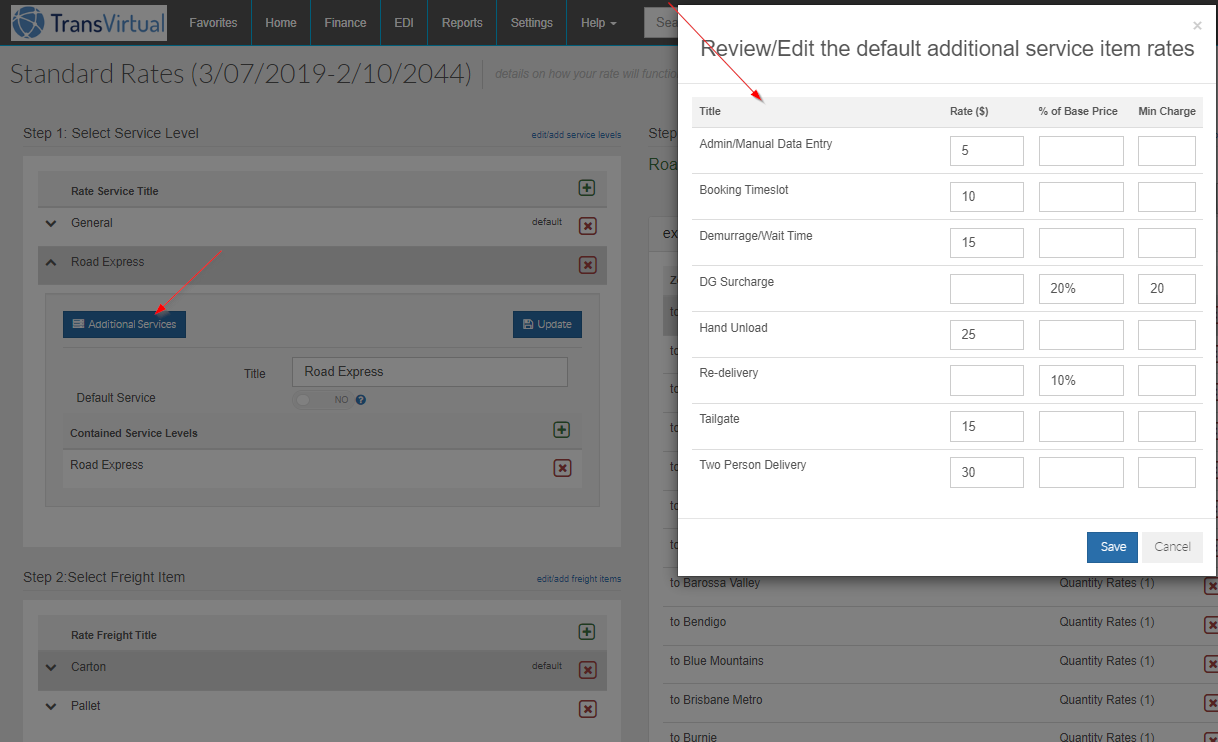
Automating Wait Time/Demurrage Charges
If required, it is possible to have a 'Wait Time' charge auto-add per the time the delivery driver was onsite performing a delivery (or a pickup - setup is very similar as per below).
To begin, this setting will need to be enabled for all applicable drivers in your account:
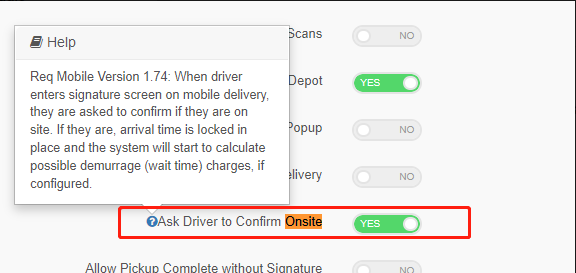
This setting can be found (and applied globally) under Settings > General > Global Setup > General Tab > OR Configuration > General > Global Setup > General Tab.
This setting can also be found against each device in the device list where you can change to the setting against a device to be different to your global default if required.
From here, you need to create an Additional Charge (or series of charges) with an appropriate name - 'Demurrage Charge (Delivery)', for example.
Once created, you need to amend the data filter located at the bottom as this is how the charge will automatically add to applicable consignments.
To do so, from Step 1 select either of the two below fields depending on whether this is to apply to pickups or deliveries (the below is an example only):
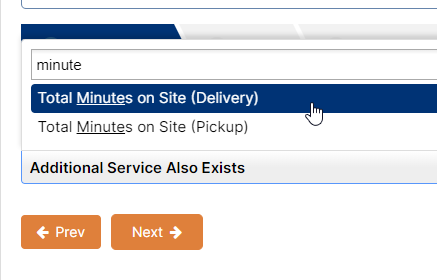
To begin, this setting will need to be enabled for all applicable drivers in your account:
This setting can be found (and applied globally) under Settings > General > Global Setup > General Tab > OR Configuration > General > Global Setup > General Tab.
This setting can also be found against each device in the device list where you can change to the setting against a device to be different to your global default if required.
From here, you need to create an Additional Charge (or series of charges) with an appropriate name - 'Demurrage Charge (Delivery)', for example.
Once created, you need to amend the data filter located at the bottom as this is how the charge will automatically add to applicable consignments.
To do so, from Step 1 select either of the two below fields depending on whether this is to apply to pickups or deliveries (the below is an example only):
 The setup for pickups is largely the same - just select the other field from step 1.
The setup for pickups is largely the same - just select the other field from step 1.
For this example, the top option for Delivery will be chosen.
Click Next and proceed to Step 2.
In Step 2 select Greater Than and then click Next:
In Step 3, specify the minute value you wish to start charging from and then click Add Rule:
The data filter will then populate with the logic you have added:
In the above example, the additional charge will be auto-added to any consignments where the driver has been at the delivery location for longer than 2 minutes.

Make sure to set a price against this Additional Charge!
Things to note for this:
- The time charged will be the number of minutes between the driver confirming onsite and delivery completion minus the time value specified in your Additional Service data filter. For example, if your data filter starts applying after 2 minutes onsite and the driver is onsite for 10 minutes in total (between arrival and delivery completion), the charge would be for 8 minutes if using a setup like the above example.
- The driver does not need to select this additional charge on their device for it to auto-add to applicable consignments. It will auto-add as expected provided the driver is prompted to confirm they have arrived onsite and does so accordingly.
- The driver must be at the receiver location for this to work as expected as TransVirtual uses GPS information in conjunction with this setup to auto-apply wait times. This process will not work if the driver confirms onsite when not actually at the receiver location.
- It is possible to set the Additional Charge to apply in increments, like the below example:

You have the ability to nominate a time in brackets after the additional service name - if doing so, the price you list will be how much the system charges for that increment. For example:

In the above, every 5 minute increment that the driver is onsite will incur a $1.50 charge - for example, if the driver has been onsite for 10 minutes then the charge qty would be 2 and the price would be 2 x $1.50.
For this to work as expected the formatting MUST be like (5 Mins) or (10 Mins) or (15 Mins) etc.
You have the ability to nominate a time in brackets after the additional service name - if doing so, the price you list will be how much the system charges for that increment. For example:
In the above, every 5 minute increment that the driver is onsite will incur a $1.50 charge - for example, if the driver has been onsite for 10 minutes then the charge qty would be 2 and the price would be 2 x $1.50.
For this to work as expected the formatting MUST be like (5 Mins) or (10 Mins) or (15 Mins) etc.
- If you are wanting to set these charges up for both pickup and deliveries you MUST have separate Additional Charges, like the below as an example:
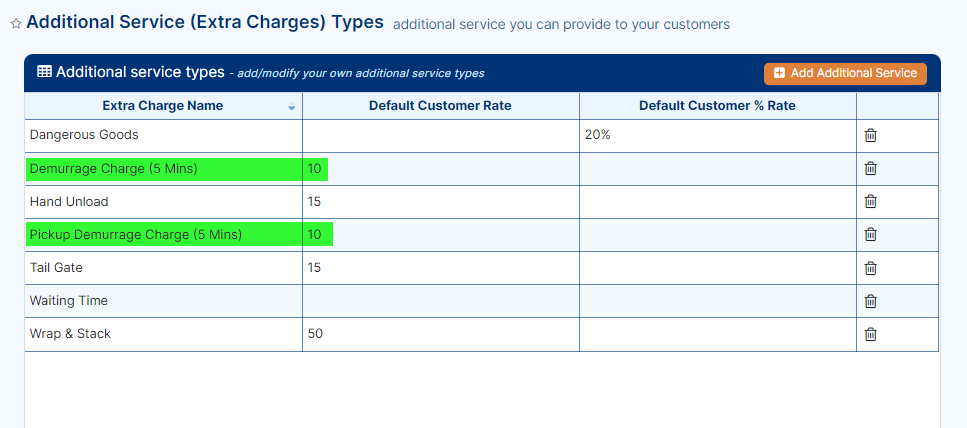
Your data filter for the delivery charge could look like the below (you need to use the delivery option):
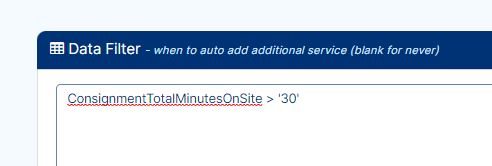
Your data filter for the pickup could look like the below (you need to use the pickup option):
Your data filter for the pickup could look like the below (you need to use the pickup option):
You CAN'T have one Additional Charge with a data filter like the below:
The reason for this is that there may be times where a driver is onsite for more than 30 minutes for the delivery but not for the pickup component - if this were to happen then the system would calculate the charge amounts for both components and possibly provide a negative value (if the negative pickup amount 'out-weighed' the positive delivery amount).
Instead, each Additional Demurrage Charge MUST be separated by the type of consignment it would apply to - pickup or delivery.
Instead, each Additional Demurrage Charge MUST be separated by the type of consignment it would apply to - pickup or delivery.
Related Articles
Additional Service EDI Export
Additional Service EDI Export In TransVirtual there is the ability to create Additional Service EDI (Electronic Data Interchange) Export Rules that can send out information from TransVirtual to a location; this can be done using FTP, Email, etc. ...Additional Service Approval
Approving an Additional Service Once an Additional Service has been added to a consignment it may need to be approved before customer invoices can be finalized. The best way to approve Additional Services is using the Additional Service Approvals ...Service Levels
Service Levels Service Levels play a crucial role in TransVirtual as they are used to determine what type of freight a consignment falls under and are therefore very important in pricing a consignment. A list of the Service Levels in your account can ...Customer Service Tickets
Customer Service Tickets Customer Service Tickets are a vital function in TransVirtual, they are used for customers to raise issues with your staff; they can ask for assistance in relation to any consignments experiencing issues. This article will ...Customer Service Ticket EDI Export
Customer Service Ticket EDI Export In TransVirtual there is the ability to create Customer Service tickets against a consignment. The purpose of these tickets is to raise any issues to the the attention of your team so that they can be resolved. ...